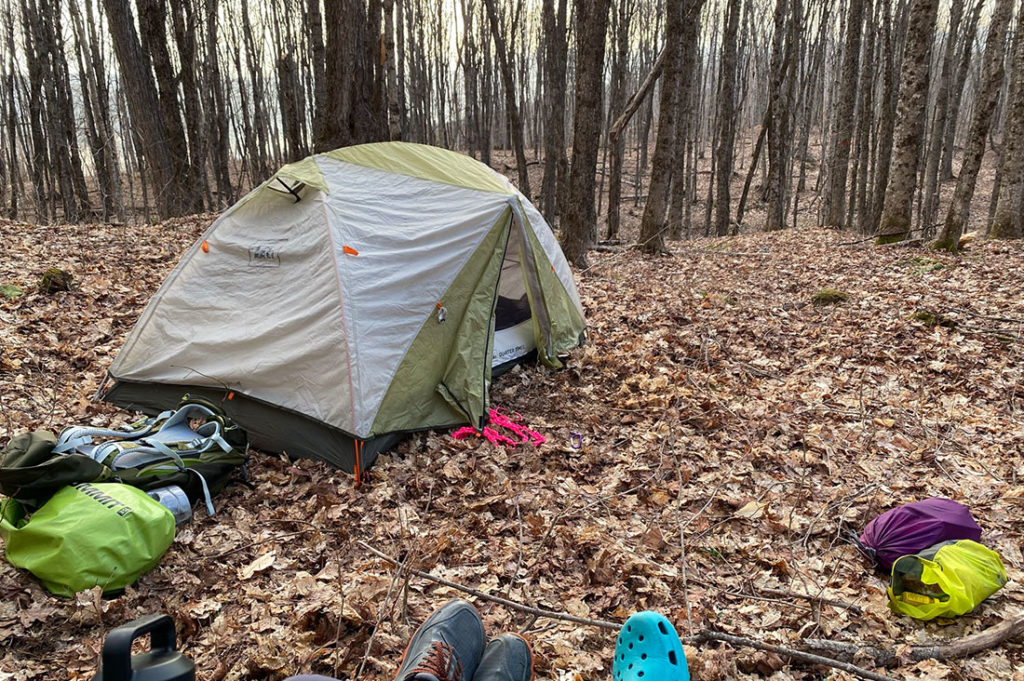
“Leave No Trace” means protecting wild areas from negative human impacts. There are seven Leave No Trace (LNT) principles that help us to protect natural areas. Check out these LNT activities, and complete at least three (in the woods, in your town, or in your backyard) to finish GMC’s Mud Madness challenge. Share photos by tagging #GMCMudMadness on Instagram.
 #1. Plan & Prepare
#1. Plan & Prepare
Why does this matter? Mud season can create extra planning challenges as snowmelt and rain flood trails. Checking weather reports, maps, and equipment ahead of your trip can help you stay safe and protect natural resources. More information.
Activity: Scouting Mission
Pick an open trail from GMC’s hike suggestions or Trail Finder. Consider the distance, weather, and trail conditions. Take a picture of everything you’ve packed to be safe and prepared for your journey — or to turn back if you encounter mud!
 #2. Travel & Camp on Durable Surfaces
#2. Travel & Camp on Durable Surfaces
Why does this matter? We think about durable surfaces –like paved bike trails and gravel paths—a lot during mud season. Muddy trails and campsites are fragile, and likely to be damaged by users. Durable surfaces can withstand the foot traffic. More information.
Activity: Move & Groove
Moving your body is half the fun in getting outdoors, and gravel paths are as fun to move around on as muddy fields. Visit a paved bike path, gravel trail, or cobblestone walkway. Record a fun movement —like dancing, skipping, biking, or cartwheeling—on the durable surface.
 #3. Dispose of Waste Properly
#3. Dispose of Waste Properly
Why does this matter? As snow melts, it can expose trash from winter trail users. Food scraps can attract wild animals, bringing them too close to humans. Plastic waste can also entangle and harm animals as well. No matter what kind of waste, it’s also unsightly for trail users. More information.
Activity: Neighborhood Cleanup
Pack a trash bag and rubber gloves for your next hike, walk, or park visit. Pick up at least five (5) pieces of trash and dispose of or recycle it properly. Be careful not to pick up anything sharp, like metal or broken glass. If public trash bins are overflowing, dispose of the trash at home. Take note of the trash you picked up—like snack wrappers, soda cans, and food crumbs. How do you think it got there?
 #4. Leave What You Find
#4. Leave What You Find
Why does this matter? Exploring nature can be so much fun, and it’s tempting to take home the interesting stuff you might find. Leaving cool rocks, sticks, feathers, shells, or wildflowers where you find them not only helps wildlife, but other trail users will also get to enjoy them. More information.
Activity: Nature Journal
Take a notebook and pencil with you on your next outdoor adventure. Notice something cool like a precious stone, arrowhead, or wildflower? Record your findings like a scientist. Draw what you see and write down where you found it. What other observations can you record about the object and environment?
 #5. Minimize Campfire Impacts
#5. Minimize Campfire Impacts
Why does this matter? Campfires provide light, heat, and a place to gather with friends. However, they aren’t suitable for all environments; there could be a lot of flammable leaf litter, it might be super windy, or there may not be much dry wood nearby. Consider these factors to determine if a campfire is a good idea. More information.
Activity: Light Display
Campfires are useful and fun during outdoor adventures, but sometimes it’s too dangerous to have them. Instead, create your own light display. Shine flashlights on clear water bottles to disperse light, hang lanterns, use a backyard firepit, or design your own paper lanterns. Get creative and share a picture of your light display.
 #6. Respect Wildlife
#6. Respect Wildlife
Why does this matter? When visiting nature, it’s important to remember that it is home to many animals. Quick movements and loud noises can stress wildlife. Do not chase, pick up, get close to, or feed animals. It’s also important not to block or pollute their homes (like rivers). This keeps them (and you) safe from stress and disease. More information.
Activity: Bird Brain
When in nature, it’s important to respect wildlife by keeping your distance. Birds are fun to observe because of their beautiful colors and flight patterns, but you don’t have to see them to know they’re nearby. Learn two local bird songs and see if you can identify them in a wild space or your backyard. Record the song or mimic it yourself and share what you learned on your adventure.
 #7. Be Considerate of Other Visitors
#7. Be Considerate of Other Visitors
Why does this matter? Loud noises, uncontrolled pets, and litter and graffiti can hinder someone else’s outdoor experience. Consider how your adventure preferences—such as music or pets—might affect others, and plan solutions like earbuds or a leash for Sparky. More information.
Activity: Trail Magic
Protecting the outdoors is a community effort. What can you do to make nature an enjoyable experience for everyone? Try volunteering with a trail management crew, organized cleanup, or search and rescue, or leave trail magic for hikers and other recreationists. Need more info? Call up your local government agency or nonprofit and share what you learned online.
Download your Leave No Trace activity sheet here (PDF). Complete at least three LNT activities, and upload your LNT photos to Instagram. Make sure your profile is public and tag #GMCMudMadness to participate in GMC’s Mud Madness challenge. Winners will be selected on Monday, April 26.



















[…] trail steward and minimize the imprint you leave on the backcountry. Try this family-friendly Leave No Trace Activity Sheet to involve young ones in our relationship to the outdoors. Last year, GMC Visitor Center […]